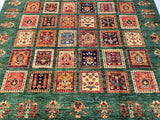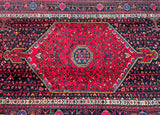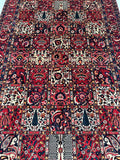Learn About Persian Rugs
Unveiling the Origins of Dyes in Persian Rugs
Persian rugs are renowned worldwide for their exquisite craftsmanship and captivating designs. One of the key elements that contribute to their timeless beauty is the vibrant colors that adorn these masterpieces. But have you ever wondered where the dyes for Persian rugs come from? In this blog post, we will explore the fascinating world of dyes used in handmade Persian rugs, focusing on natural dyes and their origins, as well as chrome dyes and how they differ. Join us on this colorful journey!
Section 1: The Magical World of Natural Dyes
Natural dyes have been used for centuries to infuse Persian rugs with rich, authentic hues. Derived from various plant sources, these dyes are carefully extracted to create a diverse color palette. Let's delve into the origins of some commonly used natural dyes:
1.1. Madder Root: A Deep Red Elixir
Madder root, obtained from the Rubia tinctorum plant, is a magnificent source of red hues. This ancient dye has been cherished for centuries and continues to be a staple in Persian rug making. The roots are carefully harvested, dried, and ground to create a pigment that ranges from soft pinks to deep reds.
1.2. Indigo: The Mystical Blue
Indigo, derived from the Indigofera tinctoria plant, is famous for its mesmerizing blue tones. This natural dye has been used since ancient times and is still highly valued today. Persian weavers skillfully extract the color from the plant's leaves and stems, resulting in a spectrum of captivating blues.
1.3. Walnut Shells: Earthy Browns
Walnut shells are another significant natural dye source for Persian rugs. The husks of these nuts yield a range of warm brown tones. Persian artisans have mastered the art of extracting the dye from these shells, imbuing their rugs with earthy elegance.
Section 2: Chrome Dyes: A Modern Journey
While natural dyes hold a special place in the hearts of rug enthusiasts, the advent of chrome dyes brought a revolution to the rug-making industry. These synthetic dyes offer a wider range of colors and increased colorfastness. Here's how chrome dyes differ from their natural counterparts:
2.1. Synthetic Brilliance
Chrome dyes, also known as synthetic or aniline dyes, are created in laboratories. Unlike natural dyes, which require meticulous extraction processes, chrome dyes are chemically synthesized to produce bright and vivid colors. This versatility allows weavers to explore a broader spectrum of hues.
2.2. Enhanced Colorfastness
One of the main advantages of chrome dyes is their superior colorfastness. These dyes bond effectively with the wool fibers, resulting in rugs that retain their vibrant colors for extended periods. This durability makes chrome-dyed rugs ideal for high-traffic areas.
2.3. A Broader Color Palette
With chrome dyes, weavers can achieve an extensive range of colors that may be challenging to replicate using natural dyes alone. From bold reds to vibrant purples, chrome dyes offer endless possibilities to bring artistic visions to life.
Persian rugs are not only a testament to skilled craftsmanship but also to the art of dyeing. While natural dyes have a timeless charm and connection to tradition, chrome dyes have opened up new horizons for rug makers, allowing for a more extensive color palette and enhanced longevity. Whether you're captivated by the allure of natural dyes or the modern vibrancy of chrome dyes, each hue on a Persian rug tells a unique story. The next time you admire a handcrafted Persian rug, take a moment to appreciate the journey of its colors, from the roots of plants to the chemistry of the lab. If you're in search of exquisite Persian rugs that showcase the beauty of natural and chrome dyes, Shoparug offers a curated collection that will bring warmth and elegance to your space.









